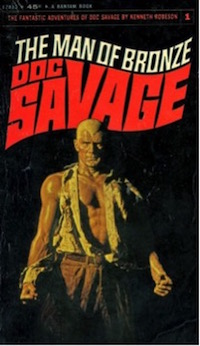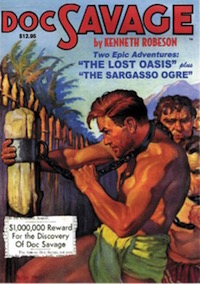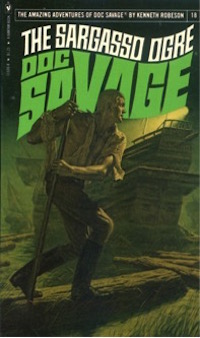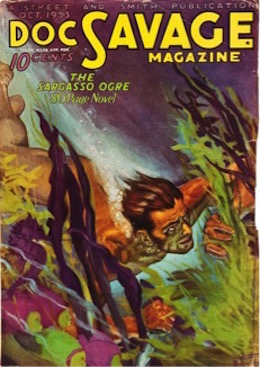In this monthly series reviewing classic science fiction books, Alan Brown will look at the front lines and frontiers of science fiction; books about soldiers and spacers, explorers and adventurers. Stories full of what Shakespeare used to refer to as “alarums and excursions”: battles, chases, clashes, and the stuff of excitement.
“MAN OF BRONZE, of sterling qualities, of unusual goal in life—this is Doc Savage. As leader of his small band of determined scrappers, eager for adventure, he is the idol of millions to-day, and his life is held up as an example to all who wish to give to life as much as they get out of it.”
These words are from an in-house ad in the Doc Savage Magazine, a publication that inspired many retellings of Doc’s adventures in other media. The recent news that director Shane Black and lead actor Dwayne “The Rock” Johnson will be bringing his adventures to the silver screen has renewed interest in this pulp icon, so let’s take a trip together back to the days when newsstands were full of pulp magazines crammed with tales of intrepid adventurers and thrilling deeds and learn more about this mysterious hero!
Doc Savage first appeared in his eponymous magazine in 1933. His adventures were penned under the house name of Kenneth Robeson, but the bulk of them were written by Lester Dent. The character was co-created with Dent by John Nanovic and H. W. Ralston, editors for Street & Smith publications, and was partially inspired by the former Street & Smith writer, and real-world adventurer, Colonel Richard Henry Savage. Author Lester Dent was an adventurer and world traveler himself, and his first-hand experience with different lands and cultures gave the stories a sense of realism that was lacking in many other pulp tales. Doc’s actual name was given as Clark Savage, Junior, and he was portrayed as the son of a scientist. His father had given the boy an upbringing that involved demanding physical and intellectual training, which gave Doc powers that were at the peak of human capabilities. His bronze-colored hair and eyes and his tanned skin inspired his nickname, the “Man of Bronze.” He was also raised with a strong moral code, and was portrayed as chaste and altruistic as a monk, a feature that made his books attractive to the parents of the young boys who were drawn to the magazine for its action and adventure. Doc’s first appearance preceded that of Superman, so he is often referred to as the first superhero, and many have pointed out that both his first name (Clark) and his use of an Arctic base called the Fortress of Solitude were features that appeared later in Superman comics. Doc Savage Magazine became a quick success and was among the bestselling pulp adventure books at the time, lasting until 1949—long after many of its rivals disappeared from the newsstands.
 I myself encountered Doc years later, when Bantam Books reprinted the series in paperback starting in 1964, and the series was once again a big success. While the old pulp magazines had disappeared, there was a big market for genre fiction in those days, and westerns, romances, detective stories, and SF novels were very popular. Novels were shorter in those days, and the Doc Savage books, which were generally in the range of 50,000 words in length, were perfect for the time. And Bantam did a great job with the presentation of the books: they hired artist James Bama to do the covers, and he used a distinctive style, with a single color generally dominating the cover, and Doc Savage at center stage. Bama’s portrayal of Doc was a powerful one. Doc was shown with the physique of a bodybuilder, with his rippling muscles generally exposed by a ripped-to-shreds shirt. The more conventional haircut shown on the old pulp covers was replaced by a crewcut with a severe widow’s peak. Combined with cover copy as lurid as that on the original pulps, you had a book that called out to youngsters in search of adventure tales, youngsters like me. To show how important Doc Savage was to me, I was willing to spend my entire allowance, which in those days was 50 cents a week, on his latest adventure—and 50 cents could buy a lot of things in those days. Four comic books, four Cokes (with a deposit on each bottle), ten candy bars, a Matchbox car, or enough penny candy to get you good and sick. But I considered it money well spent. Bantam eventually reprinted the entire series, and kept the books in print until the 1990s.
I myself encountered Doc years later, when Bantam Books reprinted the series in paperback starting in 1964, and the series was once again a big success. While the old pulp magazines had disappeared, there was a big market for genre fiction in those days, and westerns, romances, detective stories, and SF novels were very popular. Novels were shorter in those days, and the Doc Savage books, which were generally in the range of 50,000 words in length, were perfect for the time. And Bantam did a great job with the presentation of the books: they hired artist James Bama to do the covers, and he used a distinctive style, with a single color generally dominating the cover, and Doc Savage at center stage. Bama’s portrayal of Doc was a powerful one. Doc was shown with the physique of a bodybuilder, with his rippling muscles generally exposed by a ripped-to-shreds shirt. The more conventional haircut shown on the old pulp covers was replaced by a crewcut with a severe widow’s peak. Combined with cover copy as lurid as that on the original pulps, you had a book that called out to youngsters in search of adventure tales, youngsters like me. To show how important Doc Savage was to me, I was willing to spend my entire allowance, which in those days was 50 cents a week, on his latest adventure—and 50 cents could buy a lot of things in those days. Four comic books, four Cokes (with a deposit on each bottle), ten candy bars, a Matchbox car, or enough penny candy to get you good and sick. But I considered it money well spent. Bantam eventually reprinted the entire series, and kept the books in print until the 1990s.
Will Murray, a pulp magazine fan and historian, has continued the Doc Savage series by writing a number of books for various publishers, starting with Bantam Books as they finished their run of original works by Dent. Murray has taken on the duties of literary executor for Dent’s estate, and is the consulting editor for Doc Savage reprints from Nostalgia Ventures that started appearing in 2006. These volumes are in a large paperback magazine format, and each contains two Doc Savage books, with cover material from both the original pulps and the Bantam reprints, original pulp interior illustrations and promotional material, and historical pieces about Lester Dent and Doc Savage, often written by Murray (essays that helped me with the background material for this article, I might add). I had the pleasure of meeting Will Murray at a New York Comic Con a few years ago, and it was very apparent his work on Doc Savage is a labor of love. Murray has been involved with many pulp and superhero characters over the years, and in an interesting side note, he created the character Squirrel Girl for Marvel Comics with legendary artist Steve Ditko in 1992—a character whose light-hearted adventures have become very popular in recent years.
Doc Savage has also appeared in other media over the years. He appeared in radio plays during the pulp era, and many comic book publishers have attempted to relaunch his adventures, with varying degrees of success. Recently, there were even a couple of full cast audio dramas released on compact disk. There was also a Doc Savage movie released in 1975, which starred Ron Ely. It was not successful, a fact many people attributed to an overly campy approach, budget problems in its production, and the use of military marches as a soundtrack. I have never seen the movie, being warned away from it by friends and fellow fans, who suggested that if I loved Doc Savage, I would dislike the movie. The most recent movie news, however, has been met with some excitement, as Shane Black is a respected director of action movies including the well-received Iron Man 3, and Dwayne Johnson is one of the hottest action stars in Hollywood these days. Johnson is a good pick for playing Doc Savage, as he looks like a James Bama illustration come to life, and is an intelligent and witty actor with a lot of range.
 Doc Savage’s adventures always appeared in an imaginative setting, and I would be remiss if I didn’t touch upon that setting, his inventions, and his team. His headquarters and personal laboratory was on the upper floors of one of the highest buildings in New York City, which was strongly hinted to be the Empire State Building, although Dent never confirmed that in the series. Doc almost always wore a vest with pockets full of his personal inventions, which frequently included gas pellets that always delivered exactly the right amount of knockout gas to have the desired effect on his opponents. He didn’t carry guns himself, and avoided killing if possible. His vest also included makeup and prosthetics, and Doc was a master of disguise. His team often carried compact machine pistols of Doc’s own invention, which in later adventures could fire “mercy bullets” that, like his gas pellets, delivered just the right amount of toxins to disable without permanently harming opponents. Doc also ran a facility in upstate New York where he sent captured criminals who were reformed with brain surgery and behavioral therapy—a practice with might have sounded scientific and progressive back in the 1930s, but just sounds creepy and unethical to modern ears. And I’ve already mentioned his Fortress of Solitude, a repository of inventions and information in the far North. Doc had a waterfront facility in the city, the “Hidalgo Trading Company,” where he stored a wide range of vehicles, including seaplanes, boats, cars, trucks, and even submersibles. When I first started reading Doc’s adventures in the 1960s, it took me a while to realize that they were set in a generation before mine. I assumed the war that he and his team had served in was WWII, not WWI, and because many of the devices he used were on the cutting edge of science, they wouldn’t have been too out of place in the mid-1960s. Looking back on those stories, Doc’s adventures were not only early forms of the superhero genre, they also were a prototype for the techno-thriller genre.
Doc Savage’s adventures always appeared in an imaginative setting, and I would be remiss if I didn’t touch upon that setting, his inventions, and his team. His headquarters and personal laboratory was on the upper floors of one of the highest buildings in New York City, which was strongly hinted to be the Empire State Building, although Dent never confirmed that in the series. Doc almost always wore a vest with pockets full of his personal inventions, which frequently included gas pellets that always delivered exactly the right amount of knockout gas to have the desired effect on his opponents. He didn’t carry guns himself, and avoided killing if possible. His vest also included makeup and prosthetics, and Doc was a master of disguise. His team often carried compact machine pistols of Doc’s own invention, which in later adventures could fire “mercy bullets” that, like his gas pellets, delivered just the right amount of toxins to disable without permanently harming opponents. Doc also ran a facility in upstate New York where he sent captured criminals who were reformed with brain surgery and behavioral therapy—a practice with might have sounded scientific and progressive back in the 1930s, but just sounds creepy and unethical to modern ears. And I’ve already mentioned his Fortress of Solitude, a repository of inventions and information in the far North. Doc had a waterfront facility in the city, the “Hidalgo Trading Company,” where he stored a wide range of vehicles, including seaplanes, boats, cars, trucks, and even submersibles. When I first started reading Doc’s adventures in the 1960s, it took me a while to realize that they were set in a generation before mine. I assumed the war that he and his team had served in was WWII, not WWI, and because many of the devices he used were on the cutting edge of science, they wouldn’t have been too out of place in the mid-1960s. Looking back on those stories, Doc’s adventures were not only early forms of the superhero genre, they also were a prototype for the techno-thriller genre.
Doc’s team was full of colorful characters, who were all given quirks and distinguishing characteristics that made them easy to remember. These characteristics were mentioned in every adventure for the benefit of new readers, and because of that repetition, I remember them clearly to this day. My favorite member of the team was “Ham” Brooks, a tall, urbane lawyer, who always carried a cane which concealed a sword. To his distress, Ham was never far from “Monk” Mayfair, a brilliant chemist who resembled an ape in human form, and was as crude as Ham was sophisticated. The two of them appeared in more adventures than any other of Doc’s sidekicks, bickered constantly, and were often romantic rivals, frequently attracted to the damsels who came to Doc for assistance. “Renny” Renwick was a civil engineer, a big burly man with massive fists that could easily punch through a wooden door, and a penchant for exclaiming, “Holy Cow!” when excited. “Johnny” Littlejohn was a geologist and archaeologist who was blind in one eye, and had a magnifying glass installed in his glasses over that eye, ready for instant use both in his profession, and in the many scrapes the team found themselves in. His catchphrase was, “I’ll be superamalgamated!” and he was prone to using fifty-cent words that certainly increased the range of my young vocabulary. The final member of the team was electrical engineer “Long Tom” Roberts, who was frail but tougher than he looked, and often cooked up gadgets on short notice to help the team in their adventures.
All of the team, with the exception of Johnny, had served as officers in WWI. While not formally part of the team, they were often joined by “Pat” Savage, a female cousin of Doc’s, who was sometimes patronized for being a woman, but always proved that she was able to hold her own in a tight situation. And since I am talking about characters, I would be remiss if I didn’t warn modern readers that the prejudices of the time were sometimes on display in the description and portrayal of some of the minor characters and villains that the team encountered in their travels.
 The book I chose to revisit for this column is one of Dent’s best. The Sargasso Ogre was a personal favorite of mine from the first time I read it. The version I chose to read is one of the Nostalgia Ventures editions that pairs the tale with The Lost Oasis, another fine adventure story featuring a lost zeppelin in a desert locale. And in Will Murray’s historical notes I learned two interesting facts: the first is that Dent’s widow reported that The Sargasso Ogre was his favorite of all the Doc Savage adventures he wrote. The second is that the rather abrupt ending that I encountered when first reading it was the product of some rather ruthless editing to make it fit the magazine, and that this Nostalgia Ventures version restores a full page at the end of the story, which includes the customary teaser for Doc’s next adventure. The Sargasso Sea, which provides the setting of the tale, is a collection of floating sargassum seaweed that is kept in the central North Atlantic by the generally clockwise currents that guided the trade routes in the age of sail. Legend has it that there is a concentration of those weeds at the center of the Sargasso Sea so thick that it has trapped ships over the centuries. This Doc Savage book assumes that the legend is real, and uses it as a background for one of his most exciting adventures.
The book I chose to revisit for this column is one of Dent’s best. The Sargasso Ogre was a personal favorite of mine from the first time I read it. The version I chose to read is one of the Nostalgia Ventures editions that pairs the tale with The Lost Oasis, another fine adventure story featuring a lost zeppelin in a desert locale. And in Will Murray’s historical notes I learned two interesting facts: the first is that Dent’s widow reported that The Sargasso Ogre was his favorite of all the Doc Savage adventures he wrote. The second is that the rather abrupt ending that I encountered when first reading it was the product of some rather ruthless editing to make it fit the magazine, and that this Nostalgia Ventures version restores a full page at the end of the story, which includes the customary teaser for Doc’s next adventure. The Sargasso Sea, which provides the setting of the tale, is a collection of floating sargassum seaweed that is kept in the central North Atlantic by the generally clockwise currents that guided the trade routes in the age of sail. Legend has it that there is a concentration of those weeds at the center of the Sargasso Sea so thick that it has trapped ships over the centuries. This Doc Savage book assumes that the legend is real, and uses it as a background for one of his most exciting adventures.
The book begins in Egypt with Long Tom being kidnapped and rescued by Doc Savage. The treasure recovered by Doc and his team during their last adventure has drawn the attention of the local criminal element. The team sets sail for New York on the ocean liner Cameronic, only to notice that some of the passengers are acting quite strangely. Doc encounters a powerful, white-bearded man who is exercising in a manner similar to Doc’s daily regimen. When confronted, the man disappears, leaving the false white beard behind him. During Long Tom’s rescue, Doc had taken a belt from one of the attackers that’s festooned with badges from a variety of ships. Doc discovers that all of the ships had disappeared under mysterious circumstances in recent years. Doc figures out that the mystery man he encountered was a Captain Bruze, and before he and his team can do anything to stop them, Captain Bruze and piratical followers (who had been concealed among the passengers of the Cameronic) rise up and take the ship. Soon they are steaming toward the center of the Sargasso Sea, which holds not only a large collection of lost ships from every era, but also a floating pirate base.
Escaping from the pirates, Doc finds a colony of women on one of the ships, who have escaped the clutches of the pirates and are led by a beautiful and mysterious woman. Doc personally battles the pirate Bruze only to find that the man is close to his physical equal, and clever and crafty as well—a dark version of Doc himself. All the pieces are then in place for one of Doc’s most thrilling adventures, set in an alien environment that is a mystery in and of itself. Unfortunately, because I have spent so much time in this article talking about Doc in general, I will have to leave it to the readers to seek out this adventure, and find out how Doc and his crew can prevail, rescue the Cameronic, help safeguard the women of the Sargasso Sea, defeat the pirates, and uncover the mystery of how they have been supporting their sinister pirate base.
I hope this article has helped fans of Doc Savage revive some happy memories, and that I have given those of you who are not familiar with the character a taste of what is in store for you if you seek out his books. There is no better reading on a summer day than a good adventure book, short enough that it doesn’t bog you down, and gripping enough to overcome any distractions you might encounter.
So let the discussions begin! I look forward to hearing from fans of Doc Savage about your favorite characters and adventures, and hearing what you think about the new movie news. Which of his team would you like to see on the screen? Which of his opponents? Would you want to see an adventure set in New York City, or somewhere else in the world? And is there a particular tale of Doc Savage you are eager to see?
Alan Brown has been a science fiction fan for five decades, especially science fiction that deals with military matters, exploration and adventure. He is also a retired reserve officer with a background in military history and strategy.










